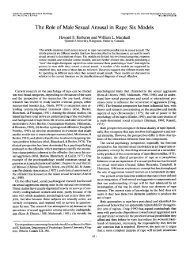Regulation of the dopamine transporter - Addiction Research ...
Regulation of the dopamine transporter - Addiction Research ...
Regulation of the dopamine transporter - Addiction Research ...
Create successful ePaper yourself
Turn your PDF publications into a flip-book with our unique Google optimized e-Paper software.
Schmitt & Reith DAT <strong>Regulation</strong><br />
transport, in addition to non–raft-associated DATs<br />
responding to PKC by a classical clathrin-dependent<br />
mechanism.<br />
On <strong>the</strong> basis <strong>of</strong> <strong>the</strong> preceding studies, it would<br />
be tempting to posit that trafficking <strong>of</strong> <strong>the</strong> DAT is<br />
mediated (at least in part) by PKC, with increased<br />
phosphorylation signaling that a given DAT protein<br />
is ready to be internalized. Recent work by<br />
Cervinski et al. 45 shows that d-methamphetamine<br />
increases DAT phosphorylation in addition to triggering<br />
internalization—both <strong>of</strong> which are prevented<br />
by PKC inhibitors. Taken toge<strong>the</strong>r, <strong>the</strong>se findings<br />
prompt a tantalizing hypo<strong>the</strong>sis positing a link<br />
between substrate interaction, <strong>transporter</strong> phosphorylation<br />
by PKC, and subsequent membrane<br />
redistribution. Unfortunately, several lines <strong>of</strong> evidence<br />
suggest that <strong>the</strong> relationship between PKC,<br />
<strong>transporter</strong> phosphorylation, and membrane trafficking<br />
is far more complex. For example, removal<br />
<strong>of</strong> three classical PKC consensus sites from <strong>the</strong> DAT<br />
protein by mutagenesis <strong>of</strong> <strong>the</strong> target residues (Ser-<br />
262, Ser-586, and Thr-613) to glycine prevents <strong>the</strong><br />
phosphorylation normally observed after PKC activation<br />
with �-PMA but fails to prevent �-PMA–<br />
induced internalization and endosomal trafficking<br />
<strong>of</strong> <strong>the</strong> DAT. 62 Similarly, truncation <strong>of</strong> <strong>the</strong> <strong>transporter</strong><br />
distal N terminus—which bears several serine<br />
residues implicated in phosphorylation after PKC<br />
activation—also eliminates �-PMA–induced DAT<br />
phosphorylation without hindering <strong>the</strong> typical endocytic<br />
response in HEK cells. 63 Fur<strong>the</strong>rmore, although<br />
removal <strong>of</strong> <strong>the</strong> serine-rich distal N terminus<br />
prevents methamphetamine-induced DAT phosphorylation,<br />
it does not affect internalization <strong>of</strong> <strong>the</strong><br />
DAT in response to <strong>the</strong> substrate. 45 That is, although<br />
PKC clearly plays a role in <strong>the</strong> mechanism underlying<br />
<strong>the</strong> trafficking effects <strong>of</strong> amphetaminergic substrates,<br />
direct phosphorylation <strong>of</strong> <strong>the</strong> DAT is not part<br />
<strong>of</strong> that role. It is possible that activation <strong>of</strong> PKC results<br />
in DAT phosphorylation via a more circuitous<br />
route, involving thus far unidentified downstream<br />
kinases; however, <strong>the</strong> observation that substrateinduced<br />
trafficking can occur without appreciable<br />
phosphorylation <strong>of</strong> <strong>the</strong> DAT protein begs <strong>the</strong><br />
question <strong>of</strong> whe<strong>the</strong>r DAT phosphorylation actually<br />
serves as a “proendocytosis” signal. Instead, it may<br />
be that PKC regulates <strong>the</strong> action <strong>of</strong> a DAT-associated<br />
scaffolding or cytoskeletal protein that is ultimately<br />
responsible for determining <strong>the</strong> trafficking fate <strong>of</strong><br />
a given DAT. 49,51 Data suggest that scaffolding<br />
proteins can control <strong>the</strong> trafficking dynamics <strong>of</strong> <strong>the</strong><br />
noradrenaline <strong>transporter</strong> (NET): <strong>the</strong> cytosolic scaffolding<br />
protein syntaxin 1A—a well-known mediator<br />
<strong>of</strong> plasmalemmal vesicle docking and fusion—<br />
directly interacts with <strong>the</strong> NET and is involved with<br />
regulation <strong>of</strong> surface NET expression levels. 64 Moreover,<br />
exposure to amphetamine results in cytosolic<br />
redistribution <strong>of</strong> plasmalemmal NETs with a concomitant<br />
increase in <strong>the</strong> association <strong>of</strong> <strong>the</strong> NET protein<br />
and syntaxin 1A at <strong>the</strong> plasma membrane. 65 It<br />
is not clear whe<strong>the</strong>r syntaxin 1A promotes <strong>the</strong> internalization<br />
<strong>of</strong> <strong>the</strong> NET or stabilizes its presence<br />
at <strong>the</strong> plasma membrane (classically, syntaxin 1A is<br />
considered an exocytosis-promoting vesicle fusion<br />
protein), but <strong>the</strong> mere interaction between <strong>the</strong> two<br />
indicates that scaffolding proteins involved in regulated<br />
vesicular neurotransmitter release may also<br />
play a role in regulating transmitter <strong>transporter</strong>s.<br />
Although explicit syntaxin 1A-dependence in<br />
amphetamine-mediated trafficking has not yet been<br />
shown with <strong>the</strong> DAT, syntaxin 1A does interact with<br />
<strong>the</strong> N terminus <strong>of</strong> <strong>the</strong> DAT, 66 and this interaction<br />
has been recently shown to promote <strong>the</strong> efflux <strong>of</strong><br />
intracellular <strong>dopamine</strong> by amphetamine. 67 Interestingly,<br />
PKC (<strong>the</strong> classical is<strong>of</strong>orm, PKC-�) is known<br />
to promote amphetamine-stimulated <strong>dopamine</strong><br />
efflux via interaction with a DAT-associated 68<br />
protein complex; PKC-� is also necessary for <strong>the</strong><br />
rapid short-term increase in surface DAT levels<br />
upon substrate exposure. 32 In <strong>the</strong> syntaxin study by<br />
Lee et al., 66 <strong>the</strong> authors also noted an interaction<br />
between <strong>the</strong> N terminus <strong>of</strong> <strong>the</strong> DAT and a protein<br />
known as <strong>the</strong> receptor for activated C kinases<br />
(RACK1). RACK1 can bind to activated PKC<br />
molecules and o<strong>the</strong>r intracellular signaling kinases<br />
and hence may help transduce increased intracellular<br />
PKC activity into a DAT proendocytosis signal<br />
without <strong>the</strong> need for a direct phosphotransferase<br />
interaction between <strong>the</strong> DAT and PKC. This<br />
protein–protein interaction might also contribute<br />
to amphetamine-induced <strong>dopamine</strong> efflux by<br />
attracting activated PKC to <strong>the</strong> <strong>transporter</strong>,<br />
promoting an inward-facing, “efflux-favoring”<br />
conformational state. 68,69 Fur<strong>the</strong>rmore, <strong>the</strong><br />
conformational state <strong>of</strong> <strong>the</strong> DAT protein itself may<br />
influence its internalization rate, because disruption<br />
<strong>of</strong> <strong>the</strong> outward-facing conformational state by mutation<br />
<strong>of</strong> membrane-proximal N-terminal residues<br />
Arg-60 or Trp-63 to alanine results in increased<br />
DAT endocytosis. 70 Substrates could encourage an<br />
Ann. N.Y. Acad. Sci. 1187 (2010) 316–340 c○ 2010 New York Academy <strong>of</strong> Sciences. 323










